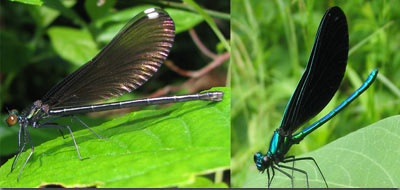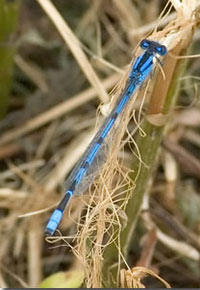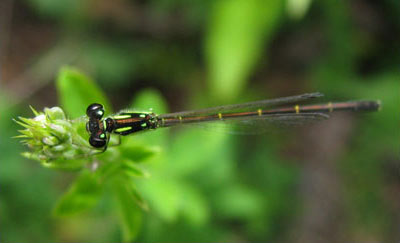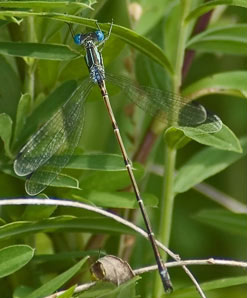In Maryland, there are 3 main families of damselflies:
Broad-winged damsels
(Calopterygidae),
Pond damsels (Coenagrionidae), and
Spreadwings (Lestidae).
Broad-winged Damsels
Family: Calopterygidae
Broad-winged damselflies tend to be large damselflies that have metallic
colored bodies. Depending on the way light strikes their bodies, these
damselflies may appear blue, green or bronze. The broad-winged damselfly
group contains both jewelwings and rubyspots. Jewelwings have black wings or
half black wings, while the Rubyspots show a red patch on the base of the
wings. This is the only damselfly family in which the males display
courtship behavior, and the females select mates.
Ebony jewelwing (Calopteryx maculata)
Ebony jewelwings can be found throughout Maryland. They have all black
wings and metallic greenish-blue bodies that shimmer in the sun. Females can
be distinguished from males by looking for white spots at the tops of their
wings. The white spots are known as stigmas. These little damsels are
anywhere from 1.5 to 2.25 inches in length and can be found along small and
large streams.

Female (left) & Male (right) Ebony Jewelwings, photo by Kerry Wixted
Pond Damsels
Family: Coenagrionidae
Pond damselflies are the largest group of damselflies found in the United
States. This damselfly family also contains over half of the damselfly
species found worldwide, including the smallest species of damselfly. Pond
damselflies range in color and size. Their wings tend to be attached to the
body via a short stalk, as well as colorless and narrow.
Familiar bluet (Enallagma civile)
True its name, familiar bluets are mostly blue in color. Interestingly
enough, the female may climb down the stem of a wetland plant and go
completely underwater to lay her eggs. The male usually protects her from
above the water. These damsels are generally 1.2-1.5 inches in length and
can be found along most small bodies of water like ponds, stream and
ditches. You may even be able to see these little gems in your backyard
after a heavy rain!

Male familiar blue, Photo by Richard Orr
Fragile forktail (Ishnura posita)
Fragile forktails can be identified by marks on their thorax (segment
behind their head) that resemble exclamation points. Males tend to have
green marks while females tend to have blue or tan marks. Fragile forktails
are diminutive damsels that get up to 1.1 inches in length. These damsels
can be found along most small bodies of water, including ditches and
marshes. Despite their small size, fragile forktails are adept predators
which may feed on other bluets.

Male fragile forktail, photo by Kerry Wixted
Spread-wing Damsels
Family: Lestidae
This small family of damselflies defies the rule that only dragonflies
rest with their wings held out to the sides. Only occasionally will
spreadwings perch with their wings together. Spreadwings are fairly large
damsels and are usually marked with metallic bronze or green. Males tend to
have blue eyes and are more colorful than females.

Male slender spreadwing, photo by Richard Orr
For Additional Information, Contact:
Acknowledgements:
- Ebony jewelwings and fragile forktail by Kerry Wixted
- Familiar bluet and slender spreadwing by Richard Orr